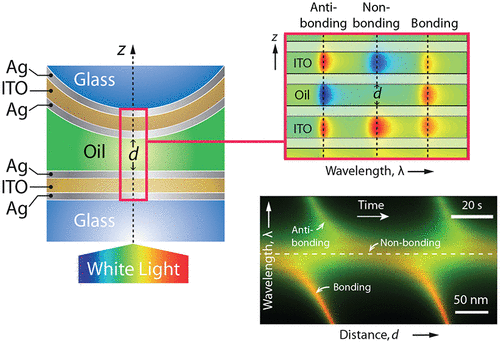当前位置:
X-MOL 学术
›
ACS Photonics
›
论文详情
Our official English website, www.x-mol.net, welcomes your feedback! (Note: you will need to create a separate account there.)
Understanding and Controlling Mode Hybridization in Multicavity Optical Resonators Using Quantum Theory and the Surface Forces Apparatus
ACS Photonics ( IF 7 ) Pub Date : 2021-11-15 , DOI: 10.1021/acsphotonics.1c01055 Bruno Zappone 1 , Vincenzo Caligiuri 1, 2 , Aniket Patra 2, 3 , Roman Krahne 3 , Antonio De Luca 1, 2
ACS Photonics ( IF 7 ) Pub Date : 2021-11-15 , DOI: 10.1021/acsphotonics.1c01055 Bruno Zappone 1 , Vincenzo Caligiuri 1, 2 , Aniket Patra 2, 3 , Roman Krahne 3 , Antonio De Luca 1, 2
Affiliation

|
Optical fields in metal-dielectric multilayers display typical features of quantum systems, such as energy level quantization and avoided crossing, underpinned by an isomorphism between the Helmholtz and Schrödinger wave equations. This article builds on the fundamental concepts and methods of quantum theory to facilitate the understanding and design of multicavity resonators. It also introduces the surface forces apparatus (SFA) as a powerful tool for rapid, continuous, and extensive characterization of mode dispersion and hybridization. Instead of fabricating many different resonators, two equal metal-dielectric-metal microcavities were created on glass lenses and displaced relative to each other in a transparent silicone oil using the SFA. The fluid thickness was controlled in real time with nanometer accuracy from more than 50 μm to less than 20 nm, reaching mechanical contact between the outer cavities in a few minutes. The fluid gap acted as a third microcavity providing optical coupling and producing a complex pattern of resonance splitting as a function of the variable thickness. An optical wave in this symmetric three-cavity resonator emulated a quantum particle with nonzero mass in a potential comprising three square wells. Interference between the wells produced a 3-fold splitting of degenerate energy levels due to hybridization. The experimental results could be explained using the standard methods and formalism of quantum mechanics, including symmetry operators and the variational method. Notably, the interaction between square wells produced bonding, antibonding, and nonbonding states that are analogous to hybridized molecular orbitals and are relevant to the design of “epsilon-near-zero” devices with vanishing dielectric permittivity.
中文翻译:

使用量子理论和表面力装置理解和控制多腔光学谐振器中的模式混合
金属电介质多层中的光场显示出量子系统的典型特征,例如能级量子化和避免交叉,这以亥姆霍兹和薛定谔波动方程之间的同构为基础。本文以量子理论的基本概念和方法为基础,以促进对多腔谐振器的理解和设计。它还介绍了表面力装置 (SFA) 作为快速、连续和广泛表征模式色散和杂化的强大工具。不是制造许多不同的谐振器,而是在玻璃透镜上创建两个相等的金属-电介质-金属微腔,并使用 SFA 在透明硅油中相对于彼此位移。流体厚度实时控制,纳米精度从超过 50 μm 到小于 20 nm,在几分钟内达到外腔之间的机械接触。流体间隙充当第三个微腔,提供光学耦合并根据可变厚度产生复杂的共振分裂模式。这个对称的三腔谐振器中的光波模拟了一个具有非零质量的量子粒子,其势能包括三个方形阱。由于杂交,孔之间的干扰产生了简并能级的 3 倍分裂。实验结果可以用标准方法和量子力学的形式来解释,包括对称算子和变分方法。值得注意的是,方形孔之间的相互作用产生了键合、反键合、
更新日期:2021-12-15
中文翻译:

使用量子理论和表面力装置理解和控制多腔光学谐振器中的模式混合
金属电介质多层中的光场显示出量子系统的典型特征,例如能级量子化和避免交叉,这以亥姆霍兹和薛定谔波动方程之间的同构为基础。本文以量子理论的基本概念和方法为基础,以促进对多腔谐振器的理解和设计。它还介绍了表面力装置 (SFA) 作为快速、连续和广泛表征模式色散和杂化的强大工具。不是制造许多不同的谐振器,而是在玻璃透镜上创建两个相等的金属-电介质-金属微腔,并使用 SFA 在透明硅油中相对于彼此位移。流体厚度实时控制,纳米精度从超过 50 μm 到小于 20 nm,在几分钟内达到外腔之间的机械接触。流体间隙充当第三个微腔,提供光学耦合并根据可变厚度产生复杂的共振分裂模式。这个对称的三腔谐振器中的光波模拟了一个具有非零质量的量子粒子,其势能包括三个方形阱。由于杂交,孔之间的干扰产生了简并能级的 3 倍分裂。实验结果可以用标准方法和量子力学的形式来解释,包括对称算子和变分方法。值得注意的是,方形孔之间的相互作用产生了键合、反键合、


























 京公网安备 11010802027423号
京公网安备 11010802027423号